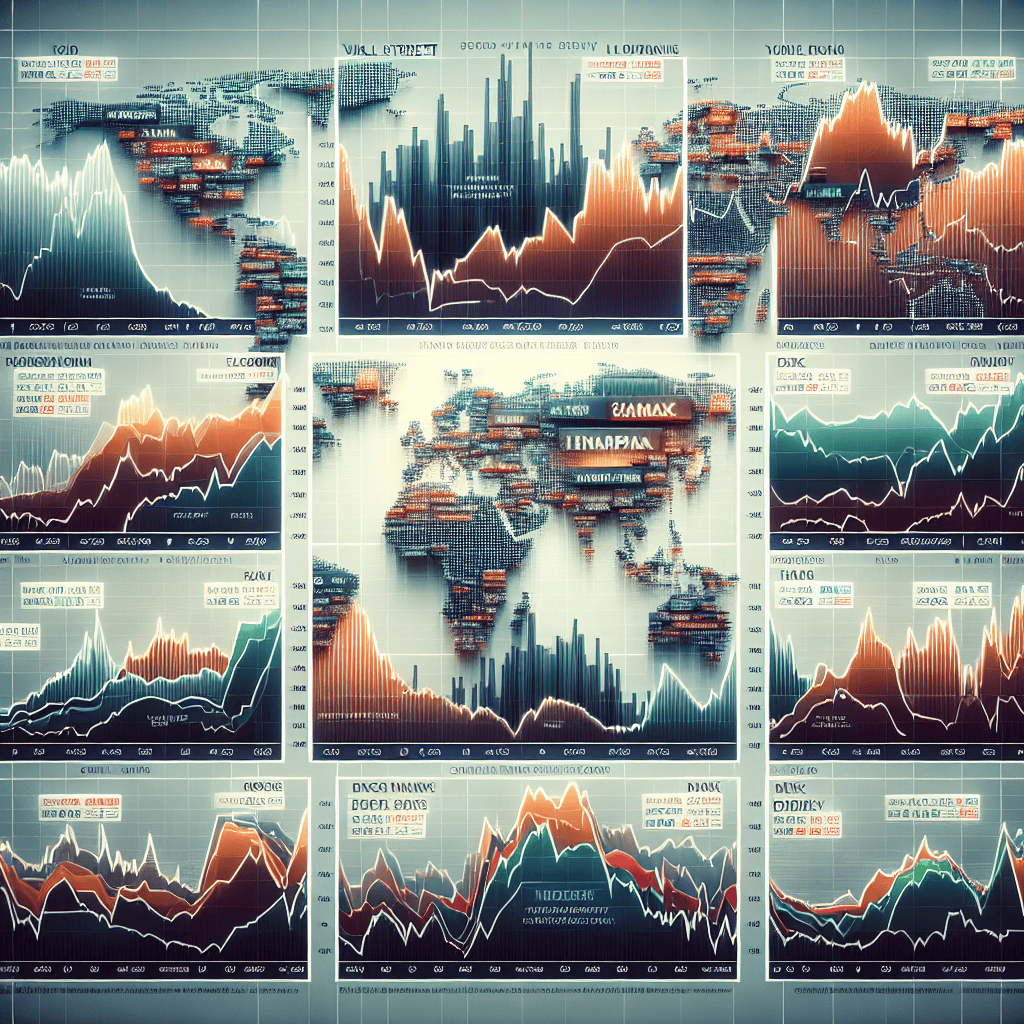“Global Markets Waver as Wall Street Stumbles for the Third Day”
Introduction
Global markets exhibited a mixed performance as investors worldwide reacted to Wall Street’s third consecutive decline. The persistent downturn in U.S. stocks has sent ripples through international financial markets, influencing trading activities across Asia, Europe, and other regions. Concerns over economic indicators, corporate earnings, and geopolitical tensions have contributed to the volatility, prompting investors to reassess their portfolios and strategies. As market participants navigate this uncertain landscape, the interplay between global economic data and regional market dynamics continues to shape the financial outlook.
Analysis Of Wall Street’s Recent Decline And Its Impact On Global Markets
The recent performance of global markets has been characterized by a mixed response following Wall Street’s third consecutive decline. This downturn in the U.S. stock market has sent ripples across international financial markets, prompting investors and analysts to reassess their strategies and expectations. The decline on Wall Street can be attributed to a confluence of factors, including concerns over inflation, interest rate hikes, and geopolitical tensions, which have collectively contributed to a sense of uncertainty among investors.
To begin with, inflationary pressures have been a persistent concern for the U.S. economy, as rising prices erode consumer purchasing power and corporate profit margins. The Federal Reserve’s response to these pressures, primarily through interest rate hikes, has been a double-edged sword. While intended to curb inflation, higher interest rates can also dampen economic growth by increasing borrowing costs for businesses and consumers. This delicate balancing act has left investors wary, as they attempt to gauge the potential impact on corporate earnings and overall economic stability.
Moreover, geopolitical tensions have further exacerbated market volatility. Ongoing conflicts and diplomatic disputes have disrupted supply chains and contributed to energy price fluctuations, adding another layer of complexity to the global economic landscape. These factors have not only affected investor sentiment in the United States but have also reverberated across international markets, leading to varied performances in different regions.
In Europe, for instance, markets have shown resilience despite the challenges emanating from Wall Street. The European Central Bank’s cautious approach to monetary policy, coupled with a relatively stable economic outlook, has provided some support to European equities. However, the region is not immune to external shocks, and any escalation in geopolitical tensions or further deterioration in U.S. market conditions could pose significant risks.
Meanwhile, Asian markets have experienced a more pronounced impact from Wall Street’s decline. The interconnectedness of global supply chains means that disruptions in one region can quickly spread to others, affecting trade and investment flows. In particular, export-oriented economies in Asia are sensitive to changes in U.S. consumer demand, and any slowdown in the American economy could have ripple effects throughout the region. Additionally, China’s ongoing economic challenges, including its real estate sector woes and regulatory crackdowns, have added to the uncertainty facing Asian markets.
Despite these challenges, some emerging markets have managed to buck the trend, benefiting from strong commodity prices and robust domestic demand. Countries rich in natural resources have seen their stock markets perform relatively well, as global demand for commodities remains high. However, these markets are not without their vulnerabilities, as they remain susceptible to shifts in global risk appetite and capital flows.
In conclusion, the mixed performance of global markets in the wake of Wall Street’s decline underscores the complex interplay of factors influencing investor sentiment and market dynamics. As inflationary pressures, interest rate policies, and geopolitical tensions continue to shape the economic landscape, investors must remain vigilant and adaptable. The interconnected nature of today’s global economy means that developments in one region can have far-reaching implications, necessitating a comprehensive and nuanced approach to market analysis and investment strategy. As such, the coming months will likely require careful monitoring of both macroeconomic indicators and geopolitical developments to navigate the challenges and opportunities that lie ahead.
Factors Contributing To The Mixed Performance Of Global Markets
Global markets have recently exhibited a mixed performance, a development that follows Wall Street’s third consecutive decline. This fluctuation in market behavior can be attributed to a confluence of factors that have created an environment of uncertainty and volatility. As investors navigate these turbulent waters, it is essential to understand the underlying causes that have contributed to this mixed performance.
One of the primary factors influencing global markets is the ongoing economic data releases from major economies. In the United States, recent reports have shown signs of a slowing economy, with consumer spending and manufacturing output not meeting expectations. These indicators have raised concerns about the potential for a broader economic slowdown, prompting investors to reassess their risk appetite. Consequently, this has led to a decline in U.S. stock markets, which has had a ripple effect on global markets.
In addition to economic data, central bank policies continue to play a crucial role in shaping market dynamics. The Federal Reserve’s stance on interest rates remains a focal point for investors. With inflationary pressures persisting, the Fed has signaled its intention to maintain a tight monetary policy. This has resulted in higher borrowing costs, which have weighed on corporate profits and, by extension, stock prices. Meanwhile, other central banks around the world are grappling with similar challenges, as they balance the need to curb inflation with the desire to support economic growth.
Geopolitical tensions also contribute to the mixed performance of global markets. The ongoing conflict in Eastern Europe, coupled with trade disputes between major economies, has heightened uncertainty. These geopolitical risks have led to fluctuations in commodity prices, particularly in energy markets, where supply disruptions have caused volatility. As a result, investors are increasingly cautious, seeking safe-haven assets such as gold and government bonds, which have seen increased demand.
Moreover, currency fluctuations have added another layer of complexity to the global market landscape. The U.S. dollar has experienced periods of strength, driven by the Fed’s monetary policy and its status as a safe-haven currency. This appreciation has put pressure on emerging market currencies, making it more challenging for these economies to manage their debt obligations and import costs. Consequently, investors are closely monitoring currency movements, as they can significantly impact international trade and investment flows.
In the corporate sector, earnings reports have been a mixed bag, with some companies exceeding expectations while others have fallen short. This disparity in performance has contributed to the uneven market behavior, as investors react to company-specific news and adjust their portfolios accordingly. Additionally, sectors such as technology and healthcare have faced unique challenges, including regulatory scrutiny and supply chain disruptions, further complicating the investment landscape.
In conclusion, the mixed performance of global markets can be attributed to a combination of economic data, central bank policies, geopolitical tensions, currency fluctuations, and corporate earnings. As these factors continue to evolve, investors must remain vigilant and adaptable, carefully assessing the risks and opportunities that arise. While uncertainty remains a defining characteristic of the current market environment, understanding the interplay of these elements can provide valuable insights for navigating the complexities of global financial markets.
Investor Sentiment Amid Wall Street’s Consecutive Losses
Investor sentiment has been notably affected by Wall Street’s recent performance, as global markets exhibit mixed reactions following the third consecutive decline in the U.S. stock market. This downturn has prompted investors worldwide to reassess their strategies and consider the broader implications of such a trend. The persistent decline in Wall Street indices, including the Dow Jones Industrial Average, the S&P 500, and the Nasdaq Composite, has raised concerns about the underlying health of the U.S. economy and its potential ripple effects on global financial markets.
In the wake of these declines, Asian markets have shown a varied response. For instance, the Tokyo Stock Exchange experienced a slight uptick, driven by a weaker yen that bolstered export-oriented companies. Conversely, the Shanghai Composite Index faced downward pressure, reflecting investor apprehension about China’s economic growth prospects amid ongoing regulatory crackdowns and property sector instability. This divergence in performance underscores the complex interplay of regional economic factors and investor sentiment.
European markets have also mirrored this mixed performance, with some indices managing to eke out gains while others faltered. The FTSE 100 in London saw modest increases, buoyed by strong performances in the energy and financial sectors. However, the DAX in Germany and the CAC 40 in France struggled to maintain momentum, as concerns over inflation and potential interest rate hikes by the European Central Bank weighed heavily on investor confidence. These regional disparities highlight the nuanced nature of market reactions to Wall Street’s downturn.
The recent declines in U.S. markets can be attributed to several factors, including rising inflationary pressures, supply chain disruptions, and uncertainty surrounding the Federal Reserve’s monetary policy. Investors are particularly wary of the Fed’s potential tapering of asset purchases and the prospect of interest rate hikes, which could dampen economic growth and corporate profitability. This cautious outlook has led to increased volatility and a flight to safer assets, such as government bonds and gold.
Moreover, the ongoing geopolitical tensions and the lingering effects of the COVID-19 pandemic continue to cast a shadow over global markets. The resurgence of cases in certain regions and the emergence of new variants have raised concerns about the sustainability of the economic recovery. These uncertainties have further compounded investor anxiety, leading to a more risk-averse approach in portfolio management.
Despite these challenges, some analysts remain optimistic about the long-term prospects of global markets. They argue that the recent declines may present buying opportunities for investors with a higher risk tolerance, particularly in sectors poised for growth, such as technology and renewable energy. Additionally, the continued rollout of vaccination programs and fiscal stimulus measures in various countries could provide a much-needed boost to economic activity and investor confidence.
In conclusion, the mixed performance of global markets following Wall Street’s third consecutive decline reflects a complex interplay of economic, geopolitical, and pandemic-related factors. As investors navigate this uncertain landscape, they must remain vigilant and adaptable, carefully weighing the risks and opportunities that lie ahead. While the path to recovery may be fraught with challenges, a strategic and informed approach can help investors weather the storm and capitalize on potential gains in the evolving global market environment.
Regional Market Reactions To Wall Street’s Downturn

Global markets have exhibited a mixed performance in the wake of Wall Street’s third consecutive decline, reflecting a complex interplay of regional economic factors and investor sentiment. As Wall Street continues to grapple with uncertainties, its ripple effects are being felt across various international markets, each responding in its unique way to the prevailing economic conditions. This divergence in market reactions underscores the interconnectedness of global economies while highlighting the distinct challenges and opportunities faced by different regions.
In Asia, markets have shown a varied response to Wall Street’s downturn. Japan’s Nikkei index, for instance, has experienced a modest decline, influenced by concerns over the global economic outlook and its potential impact on Japan’s export-driven economy. Meanwhile, China’s stock markets have demonstrated relative resilience, buoyed by recent government measures aimed at stabilizing the economy and boosting investor confidence. These measures include targeted fiscal policies and monetary easing, which have provided a cushion against external shocks. However, the ongoing property sector challenges in China continue to pose a risk, potentially dampening the overall market sentiment.
Transitioning to Europe, the situation presents a different picture. Major European indices have shown a mixed performance, with some markets managing to hold steady while others have experienced declines. The European Central Bank’s recent monetary policy decisions have played a crucial role in shaping investor expectations. While the ECB’s commitment to maintaining accommodative policies has provided some reassurance, concerns over inflationary pressures and energy supply disruptions have weighed on market sentiment. Additionally, the geopolitical tensions in Eastern Europe have added another layer of complexity, influencing investor behavior and market dynamics.
In contrast, emerging markets have faced their own set of challenges and opportunities in light of Wall Street’s decline. Countries in Latin America, for example, have seen varied market reactions, largely driven by domestic economic conditions and commodity price fluctuations. Brazil’s stock market has shown resilience, supported by strong agricultural exports and a favorable commodity price environment. However, political uncertainties and inflationary pressures remain key concerns for investors. Similarly, in Africa, markets have exhibited a mixed performance, with some countries benefiting from rising commodity prices while others face headwinds due to political instability and economic vulnerabilities.
As we turn our attention to the Middle East, the region’s markets have also displayed a diverse response to the global economic landscape. Oil-rich nations have benefited from elevated energy prices, which have provided a boost to their economies and stock markets. However, the ongoing volatility in oil prices, coupled with geopolitical tensions, continues to pose risks to the region’s economic stability. In contrast, non-oil-dependent economies in the Middle East have faced challenges related to inflation and fiscal constraints, impacting their market performance.
In conclusion, the mixed performance of global markets following Wall Street’s third consecutive decline highlights the intricate web of factors influencing regional market reactions. While some regions have managed to navigate the challenges with relative stability, others continue to face significant headwinds. As global economic uncertainties persist, the interplay between domestic policies, geopolitical developments, and external economic conditions will remain crucial in shaping the future trajectory of these markets. Investors and policymakers alike must remain vigilant, adapting to the evolving landscape to mitigate risks and capitalize on emerging opportunities.
The Role Of Economic Indicators In Global Market Fluctuations
Global markets have recently exhibited a mixed performance, a development that follows Wall Street’s third consecutive decline. This fluctuation underscores the intricate relationship between economic indicators and market behavior. Economic indicators, which include metrics such as employment rates, consumer confidence, and inflation, play a pivotal role in shaping investor sentiment and, consequently, market performance. As these indicators provide insights into the health and direction of an economy, they are closely monitored by investors and policymakers alike.
To begin with, employment rates are a fundamental economic indicator that significantly influences market dynamics. High employment rates generally signal a robust economy, leading to increased consumer spending and business investment. Conversely, rising unemployment can trigger concerns about economic slowdown, prompting investors to adopt a more cautious approach. For instance, recent data indicating a slight uptick in unemployment in major economies has contributed to the uncertainty in global markets, as investors weigh the potential impact on corporate earnings and economic growth.
In addition to employment figures, consumer confidence is another critical indicator that affects market performance. Consumer confidence measures the degree of optimism that consumers feel about the overall state of the economy and their personal financial situation. When confidence is high, consumers are more likely to spend, driving demand for goods and services and boosting corporate revenues. However, a decline in consumer confidence can lead to reduced spending, which may dampen economic growth and negatively impact stock markets. Recent surveys have shown a dip in consumer confidence in several regions, adding to the mixed signals being sent to global markets.
Inflation rates also play a crucial role in determining market trends. Moderate inflation is generally seen as a sign of a growing economy, but when inflation rises too quickly, it can erode purchasing power and lead to increased costs for businesses. Central banks often respond to high inflation by raising interest rates, which can slow economic growth and affect market performance. The current global economic landscape is marked by varying inflation rates across different regions, with some economies experiencing persistent inflationary pressures while others are witnessing a stabilization of prices. This divergence in inflation trends has contributed to the mixed performance observed in global markets.
Moreover, geopolitical events and policy decisions can amplify the effects of economic indicators on market performance. Trade tensions, political instability, and changes in fiscal or monetary policy can create additional layers of uncertainty, influencing investor behavior. For example, recent geopolitical developments have heightened market volatility, as investors assess the potential implications for global trade and economic stability. These factors, combined with the existing economic indicators, create a complex environment that market participants must navigate.
In conclusion, the mixed performance of global markets following Wall Street’s decline highlights the significant role that economic indicators play in shaping market fluctuations. Employment rates, consumer confidence, and inflation are key metrics that provide valuable insights into economic conditions and influence investor sentiment. As these indicators continue to evolve, they will remain central to understanding and predicting market trends. Investors and policymakers must remain vigilant, considering both domestic and international factors, to effectively respond to the challenges and opportunities presented by the ever-changing global economic landscape.
Strategies For Investors Navigating Volatile Global Markets
In the wake of Wall Street’s third consecutive decline, global markets have exhibited a mixed performance, leaving investors to grapple with the complexities of navigating volatile financial landscapes. This period of uncertainty underscores the importance of strategic planning and informed decision-making for investors seeking to safeguard their portfolios. As market dynamics continue to shift, understanding the underlying factors contributing to this volatility becomes crucial.
To begin with, the recent downturn in Wall Street can be attributed to a confluence of factors, including concerns over inflation, interest rate hikes, and geopolitical tensions. These elements have collectively contributed to a climate of uncertainty, prompting investors to reassess their strategies. In such an environment, diversification emerges as a fundamental strategy. By spreading investments across various asset classes, sectors, and geographical regions, investors can mitigate risks associated with market fluctuations. This approach not only helps in cushioning the impact of downturns in specific areas but also provides opportunities for growth in others.
Moreover, maintaining a long-term perspective is essential when navigating volatile markets. Short-term market movements, while often unsettling, do not necessarily reflect the underlying health of an economy or the potential of individual investments. By focusing on long-term goals and maintaining a disciplined approach, investors can avoid the pitfalls of making impulsive decisions based on temporary market conditions. This strategy is particularly relevant in the current climate, where emotional reactions to market volatility can lead to suboptimal investment choices.
In addition to diversification and a long-term outlook, staying informed about global economic trends is vital. Investors should pay close attention to economic indicators, such as GDP growth rates, employment figures, and consumer confidence indices, as these can provide valuable insights into the broader economic environment. Furthermore, understanding the implications of central bank policies, particularly those related to interest rates, can help investors anticipate potential market movements and adjust their strategies accordingly.
Another key consideration for investors is the role of technology and innovation in shaping market dynamics. The rapid pace of technological advancements has the potential to disrupt traditional industries and create new opportunities for growth. By identifying and investing in sectors poised for technological transformation, investors can position themselves to benefit from these emerging trends. However, it is important to conduct thorough research and due diligence to ensure that investments in these areas align with one’s risk tolerance and investment objectives.
Additionally, investors should be mindful of the impact of geopolitical developments on global markets. Political events, such as elections, trade negotiations, and international conflicts, can have far-reaching implications for financial markets. By staying informed about these developments and understanding their potential impact on specific sectors or regions, investors can make more informed decisions and adjust their portfolios to mitigate risks.
In conclusion, navigating volatile global markets requires a multifaceted approach that combines diversification, a long-term perspective, and a keen awareness of economic, technological, and geopolitical trends. By employing these strategies, investors can better position themselves to weather market fluctuations and capitalize on opportunities for growth. As the global economic landscape continues to evolve, staying informed and adaptable will be key to achieving investment success in an increasingly complex world.
Long-term Implications Of Wall Street’s Decline On Global Economies
The recent performance of global markets has been characterized by a mixed response following Wall Street’s third consecutive decline. This trend has sparked discussions among economists and investors about the potential long-term implications for global economies. As Wall Street often serves as a barometer for global financial health, its downturn can have far-reaching effects, influencing investor sentiment and economic strategies worldwide.
To begin with, Wall Street’s decline can be attributed to a confluence of factors, including rising interest rates, inflationary pressures, and geopolitical tensions. These elements have created an environment of uncertainty, prompting investors to reassess their portfolios and risk appetites. Consequently, this has led to volatility in global markets, as investors seek safe havens or adjust their strategies in response to the shifting landscape. The ripple effects of Wall Street’s performance are evident in various international markets, where reactions have ranged from cautious optimism to outright concern.
In Europe, for instance, markets have shown resilience despite the challenges posed by Wall Street’s decline. The European Central Bank’s monetary policies and fiscal measures have provided some stability, allowing markets to weather the storm. However, the interconnectedness of global economies means that prolonged downturns in the U.S. could eventually impact European growth prospects. Similarly, Asian markets have experienced mixed results, with some economies benefiting from strong domestic demand while others grapple with the consequences of reduced exports to the United States.
Moreover, emerging markets are particularly vulnerable to the fluctuations of Wall Street. These economies often rely on foreign investment and exports to fuel growth, making them susceptible to shifts in global investor sentiment. A sustained decline in Wall Street could lead to capital outflows from emerging markets, exacerbating existing economic challenges and potentially leading to currency devaluations. This scenario underscores the importance of diversification and robust economic policies to mitigate the impact of external shocks.
In addition to immediate market reactions, the long-term implications of Wall Street’s decline on global economies warrant careful consideration. One potential outcome is a reevaluation of monetary policies by central banks worldwide. As inflationary pressures persist, central banks may be compelled to adjust interest rates, which could influence borrowing costs and investment decisions. This, in turn, could affect economic growth trajectories and employment levels across different regions.
Furthermore, the decline in Wall Street may prompt governments to implement fiscal measures aimed at stimulating economic activity. Infrastructure investments, tax incentives, and social welfare programs could be employed to bolster domestic demand and counteract the negative effects of a global slowdown. However, such measures must be carefully calibrated to avoid exacerbating fiscal deficits and debt levels.
In conclusion, while Wall Street’s third consecutive decline has led to mixed performances in global markets, the long-term implications for global economies are complex and multifaceted. The interconnected nature of today’s financial systems means that developments in one region can have cascading effects worldwide. As such, policymakers and investors must remain vigilant, adapting strategies to navigate the evolving economic landscape. By fostering resilience and promoting sustainable growth, global economies can better withstand the challenges posed by Wall Street’s fluctuations and ensure a more stable future.
Q&A
1. **What caused the decline on Wall Street?**
Concerns over rising interest rates and economic uncertainty contributed to Wall Street’s decline.
2. **How did Asian markets react to Wall Street’s performance?**
Asian markets showed mixed reactions, with some indices falling while others remained stable or rose slightly.
3. **What was the performance of European markets following Wall Street’s decline?**
European markets experienced a mixed performance, with some indices recovering slightly and others continuing to decline.
4. **Which sectors were most affected by the decline on Wall Street?**
Technology and consumer discretionary sectors were among the most affected by the decline.
5. **How did currency markets respond to the global market performance?**
The U.S. dollar strengthened against several major currencies as investors sought safe-haven assets.
6. **What impact did the decline have on commodity prices?**
Commodity prices, such as oil and gold, experienced volatility, with oil prices dropping and gold prices rising slightly.
7. **What are analysts predicting for the near future of global markets?**
Analysts predict continued volatility in global markets due to ongoing economic uncertainties and geopolitical tensions.
Conclusion
Global markets exhibited mixed performance following Wall Street’s third consecutive decline, reflecting investor uncertainty and varied regional economic conditions. While some markets showed resilience due to strong local economic indicators or sector-specific gains, others mirrored Wall Street’s downturn, influenced by concerns over inflation, interest rate hikes, and geopolitical tensions. This divergence underscores the complexity of global financial dynamics, where local factors can either mitigate or exacerbate the impact of broader market trends. As investors navigate these fluctuations, the focus remains on balancing risk and opportunity in an increasingly interconnected economic landscape.





